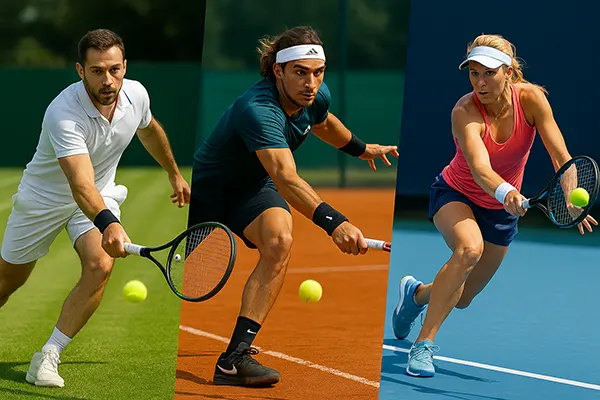Tennis is one of the most dynamic sports in terms of betting analysis due to the strong correlation between court surface and player performance. Bettors who understand how surfaces influence match outcomes can make significantly more accurate predictions, especially when evaluating totals and handicaps. In this article, we provide a detailed overview of the three main types of surfaces—grass, clay, and hard—and their impact on betting strategy, using data relevant as of February 2025.
Performance Differences Across Surfaces
Each tennis surface affects ball speed, bounce height, and player movement differently, resulting in distinct performance patterns among players. Grass courts, for example, are the fastest and produce low ball bounces, favouring aggressive serve-and-volley players. Conversely, clay courts slow down the game and offer high bounces, benefiting baseline specialists with excellent stamina. Hard courts strike a balance between speed and bounce, allowing more versatility in playstyle but also increasing physical strain over time.
Statistical data from 2024 and early 2025 ATP and WTA seasons reveals that players like Carlos Alcaraz and Iga Świątek maintain a high win percentage on clay due to their exceptional footwork and patience, while players such as Hubert Hurkacz and Aryna Sabalenka perform significantly better on faster surfaces like grass and hard. Recognising these tendencies allows bettors to predict performance dips or peaks based on the scheduled surface.
Additionally, the degree of variability in performance is also surface-dependent. Grass courts can create higher volatility due to quick points and fewer break opportunities, often resulting in closer matches and unpredictable outcomes. This unpredictability can affect betting odds and strategies such as over/under games played and set betting.
Players with the Greatest Surface Variability
Identifying players whose game drastically changes across surfaces is crucial for value betting. Daniil Medvedev, for instance, struggles on clay due to his flat shots and poor sliding technique, despite being a top-tier hard court competitor. Conversely, Casper Ruud thrives on clay but often underperforms on grass, where his heavy topspin loses effectiveness.
WTA players like Ons Jabeur and Karolína Muchová also exhibit strong surface preferences. Jabeur’s touch and slice shots are extremely effective on grass, but she finds it harder to dictate play on clay. Muchová, meanwhile, adapts well to hard courts but lacks consistency on grass due to her movement limitations.
Understanding these patterns enables bettors to avoid overestimating form based solely on recent results that occurred on different surfaces. A player on a winning streak might still be a risky pick if switching from clay to grass, and vice versa.
Impact on Totals and Handicaps
Surface characteristics significantly influence match duration, break point frequency, and service dominance, all of which affect betting markets like total games and game handicaps. For example, matches on clay generally feature longer rallies and more breaks, leading to higher totals and more frequent over scenarios. In contrast, grass matches tend to be shorter with fewer breaks, favouring unders and narrow handicaps.
Bettors should also consider tournament level and player fatigue. On faster courts, elite servers can cover game handicaps with ease, especially in early rounds. However, in best-of-five Grand Slam matches, totals might trend higher due to longer match formats, particularly on slower surfaces like clay.
In women’s matches, where three-set formats dominate, hard courts often present balanced betting opportunities. With many players capable of holding serve and breaking consistently, totals can swing based on momentum rather than surface alone—though surface still plays a role in tipping that balance.
Statistical Trends for 2024–2025
According to data compiled from the ATP and WTA circuits through February 2025, the average number of games per match on clay was 22.7, compared to 20.4 on grass and 21.6 on hard courts. This directly affects over/under bets. The highest over-hit percentage was recorded on clay at 59%, compared to 48% on grass and 53% on hard.
Moreover, player-specific stats show that on clay, players like Diego Schwartzman and Sara Sorribes Tormo often surpass game totals due to their grinding style and ability to prolong rallies. Meanwhile, on grass, servers like Nick Kyrgios (when active) and Karolína Plíšková dominate with quick service holds, making under bets more attractive.
These trends are vital for shaping pre-match expectations and live-betting decisions, especially when bookmakers lag behind in adjusting odds to match real-time developments and court dynamics.

Practical Betting Strategy by Surface
Developing a consistent tennis betting strategy requires segmenting analysis by surface type. On grass, focus on service statistics, such as first-serve percentage and aces per match. These metrics directly impact the likelihood of tiebreaks and match length. On clay, analyse break point conversion and unforced error rates, as longer rallies demand mental resilience and tactical shot-making.
Hard courts require a hybrid approach, blending surface data with player fatigue and recent form. Many injuries also occur on hard courts, so monitoring physical condition is key. Bettors should leverage this by adjusting risk in later tournament stages when fatigue compounds performance drops.
Finally, always contextualise historical data with current conditions. A player who dominated clay last year might be returning from injury or struggling with new equipment, affecting performance across all surfaces. Modern betting success relies on integrating technical analysis with contextual awareness and timing.
Advanced Tips for Bettors
Use official player stats from the ATP/WTA site or third-party services to track individual surface performance. Tools that offer head-to-head surface comparisons can highlight hidden weaknesses that don’t appear in overall form metrics. This is especially useful in early rounds where matchups are often mispriced.
Pre-match preparation should also include checking for court speed ratings released by tournament organisers. For example, Australian Open courts in 2025 were slightly faster than the previous year, which changed serve hold percentages by up to 3% for some players.
Lastly, consider environmental factors—altitude, humidity, and temperature can amplify or diminish surface effects. High altitude makes hard courts faster, while rain on clay courts slows down the game dramatically. These variables can create betting edges when overlooked by sportsbooks.
